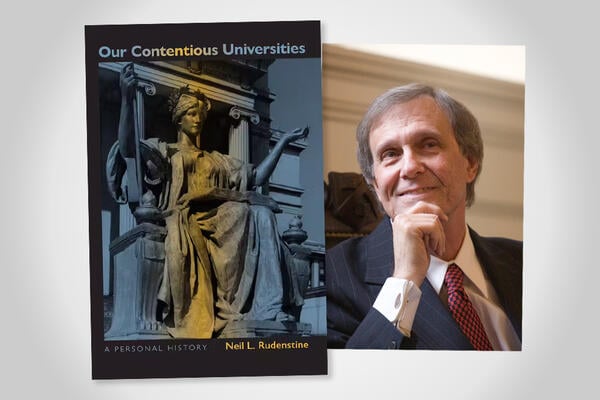In 1967, in the midst of the Vietnam War, Harvard University English professor Neil Rudenstine intervened in a protest on campus, where a recruiter from Dow Chemical Company, which made napalm, had been surrounded by students upset about U.S. attacks on Vietnamese civilians. He helped defuse the tension by negotiating with students to release the recruiter.
That foray into conflict resolution prompted an unexpected shift from a budding literary career to academic administration. Rudenstine would then go on to serve as dean of students at Princeton University and in other roles before making his way back to Harvard as president, a job he held from 1991 to 2001.
Now 90, Rudenstine released a book last month titled Our Contentious Universities: A Personal History (The American Philosophical Society Press) that is partly a memoir and partly an exploration of campus protests movements across multiple decades and causes.
Rudenstine discussed the book with Inside Higher Ed, sharing his personal experiences of protests in years past and his thoughts on the latest wave of pro-Palestinian demonstrations.
Excerpts of the conversation have been edited for length and clarity.
Q: What motivated you to write this book?
A: From my point of view, increasing student protests starting in the ’90s seemed to be different from those of the ’60s, and more complicated to deal with. So I began to try to find out what the differences were and what the results might be of the new movement, so to speak. That got me immersed to look again at the 1960s, and after that, events began to take over.
Q: What differences do you see in protests of the past versus today?
A: In the ’60s, student protests were quite violent at times, but they were all mainly concerned with the Vietnam War. Of course, there were other things, like student protests over apartheid in South Africa [in the 1980s]. But the main issue in the 1960s was the war, and students were essentially united in their feelings against the war. There was virtually no sense of students in any way protesting against one another, or student groups disagreeing with other student groups. It was a united feeling.
It was also a feeling that if the war were to come to an end, the protests would probably also come to an end. In the ’90s and afterward, students were far more diverse. There were more Black students, Jewish students, Asian American students, first-generation students and so on. These groups did not necessarily agree with one another in terms of what was important to protest against, and they sometimes protested against one another. So the situation was very different; there was no single overriding issue like the war.
Q: Tell me about your own protest experiences, starting when you were a professor at Harvard in 1967 and helped bring an end to a protest organized by Students for a Democratic Society.
A: I was, at the time, an assistant professor of English literature, and totally absorbed by that job at Harvard. One day I was walking across campus outside of Harvard Yard, and I heard shouting and cheering going on around [Mallinckrodt Laboratory], which was a chemistry building. It turned out that Students for a Democratic Society had organized a protest that imprisoned a recruiter for the Dow Chemical Company who wanted to interview students for jobs. And since Dow was making some products [such as napalm] that were used in the war, the SDS students decided to imprison this recruiter.
Purely by chance, I stopped by, and I thought it was not proper of the university to imprison a recruiter who’d come to interview students and told the students that by using their megaphone. After several hours of discussion and debate, the students released the recruiter and gave up the protest. I was somehow identified as the person who had helped to bring this about, and that led to me being asked to be dean of students at Princeton University to help with their protest movements. A very considerable accident got in the way of my literary career and deflected me from literature to student protests in a way that I had never imagined. It was purely the result of chance and serendipity.
Q: Near the end of your career, students staged a sit-in to demand a living wage at Harvard. How were you able to wind that protest down without police intervention?
A: That was a very complicated situation. Students sat in my office building, Massachusetts Hall, because they wanted to change the way in which many people at the university were reimbursed for their services. The living wage protest was not very rational. If they had wanted a minimum wage change, we might have been able to discuss it, but the method they chose was not rational, and they sat in the building for more than two weeks. So we had a very complicated and delicate situation.
I decided at the beginning that whatever we would do, we would not call the police, because calling the police in earlier days at Columbia, Harvard, Kent State and other places had led to terrible situations of riots and police beating students. So the question was, how can we not call the police but also bring the situation to a conclusion? It took many, many days of discussion and waiting in order to try to find this conclusion.
What happened was that the next president [Larry Summers] said, “Why don’t you put together a committee to look into the issue, and that will give the students a way out, and it’ll give you a way out? It’s not likely that this committee will embrace the solution that the students have chosen at all, but it’ll bring an end to the protests.” And that’s what happened. We appointed a committee, the students were able to claim the victory and walk out of the building, and we were able go back into our offices and basically say that we were happy nobody had been hurt, and that we would trust the new committee to make very good recommendations about what should be done in the future.
Q: You wrote that you were “taken aback” by how quickly presidents brought in police to break up protest encampments last spring. What other tactics do you believe they should have considered first?
A: Obviously, every situation is different, so there’s no one general thing you can do. But there is a way which you can call for the judiciary to step in. If students are identified as being in the protest, if the [judiciary] tells them to evacuate whatever building they happen to be occupying or whatever they’re doing wrong, they can be held in contempt of court if they don’t obey those admonitions. That’s a very good substitute for bringing in the police; if you’re held in contempt of court, it’s a very serious crime, and very few students want to do that, so they tend to leave right away. We had tried that at Princeton, and that seemed to be a good substitute for actually calling the police, which led, of course, to terrible things at Columbia and elsewhere, when the police tended to just brutalize the students when they were called in.
Another alternative, of course, is to wait out the students in the hope that sooner or later, their academic needs will force them to go back out and get to their studies. That was a tactic we also used at Princeton.
Q: What do you think about the institutional neutrality movement?
A: I’m a little bit skeptical about the conception and certainly the term of neutrality. I understand why people would embrace the idea at the University of Chicago, for example, and other places. I think that’s a very interesting point of view, and I think at times it’s definitely the thing to do. You don’t want to go around commenting all the time on what has happened internationally or nationally. At the same time, it’s a very difficult row to hoe, because there simply are some events that require, if not an actual stance by the university, certainly some kind of an analysis with a possible outcome. I do think that there are times when it’s important for a leader to speak out, and it has to be done very thoughtfully, and one has to choose those moments carefully.
Q: Any advice for today’s college presidents on how to handle campus protests?
A: That’s a tough one. I think what they’re doing is about as good as can be done, and that’s clarifying what is legitimate as a protest or what is not legitimate and being willing to discipline students if they really cross the line of what’s permissible in an obstructive way that harms other people’s capacity to do their jobs. I hope the universities are open to discussing in a more collaborative way things that need to be ironed out, other than simply responding with police force. The more they can discuss and analyze and find ways to reason with the students and even some faculty … the more they are able to possibly defuse protest or the threat of protest.

